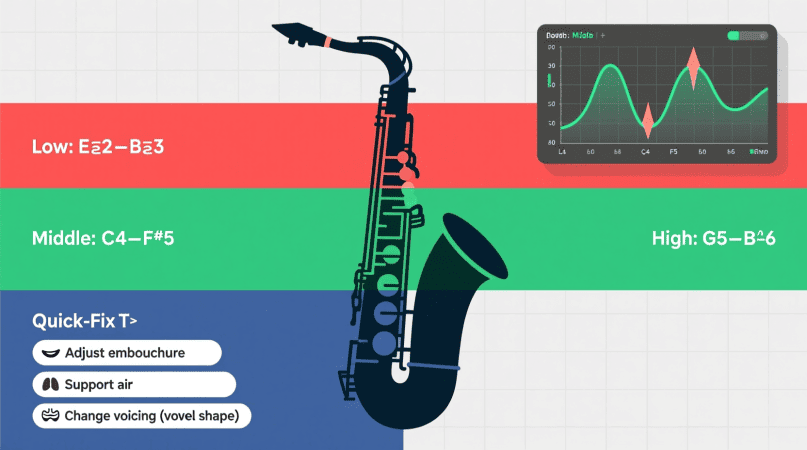
Even experienced saxophone players know the frustration of slipping out of tune. One note feels solid, while the next sounds sharp or flat. The challenge is that intonation on saxophone depends on embouchure, airflow, reed setup, and even room temperature. Traditional methods—like listening to drones or using clip-on tuners—help, but they don’t give real-time feedback across your range. That’s where pitch detection tools can make practice more precise and less stressful.
Why Saxophone Intonation Is Hard to Control
- Embouchure pressure: Too much tightness sends notes sharp, while a loose setup lets them sag flat.
- Air support: Inconsistent breath leads to pitch wobbling.
- Instrument quirks: Certain notes (like middle D or C#) are naturally unstable.
- Environment: A cold horn plays sharp until warmed up.
Recognizing these factors is the first step. The next is pairing your ear with visual pitch feedback so you can correct issues as they happen.
How Pitch Detection Helps Saxophone Players
- Instant accuracy check: See in real time if you’re sharp or flat.
- Ear training reinforcement: Eyes confirm what ears hear, speeding up learning.
- Note-by-note awareness: Spot patterns across the horn’s register.
- Confidence boost: Enter rehearsals and gigs knowing you’re in control of your tuning.
👉 Test your sax across the full range with the Voice Pitch Analyzer and map where your intonation drifts.
Step-by-Step: Staying in Tune With Pitch Detection
1. Warm Up First
Play long tones for 5–10 minutes. A cold saxophone reads sharp, so warm-up is non-negotiable.
2. Tune Your Reference Note
Most sax players tune to concert A (written B for alto, F# for tenor). Use a detector to align this note before moving on.
3. Play Scales With Feedback
Run slow scales, watching the pitch line. Notice which notes consistently pull sharp or flat.
👉 The Pitch Detector gives real-time corrections, making it easy to adjust embouchure and airflow.
4. Focus on Problem Notes
Isolate tricky notes like middle D or palm keys. Sustain them while monitoring pitch detection to stabilize control.
5. Track Your Progress
Log your accuracy over time. Are your flat notes becoming more stable? Do octave jumps stay aligned?
👉 Use Best Pitch Detection to record full sessions and see consistency over long tones, scales, and songs.
Practical Intonation Tips for Saxophonists
- Adjust with air, not fingers: Use embouchure and breath to correct pitch.
- Work on octave consistency: Compare low and high versions of the same note.
- Record yourself: Listening back reveals drift you didn’t notice live.
- Use drones alongside detectors: Layer auditory and visual feedback for stronger training.
Pitch Detector is a project by Ornella, blending audio engineering and web technology to deliver precise, real-time pitch detection through your browser. Designed for musicians, producers, and learners who want fast, accurate tuning without installing any software.
